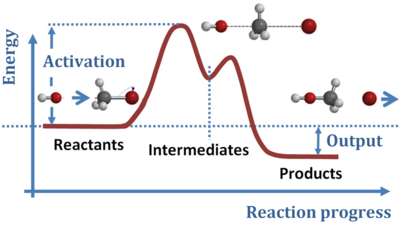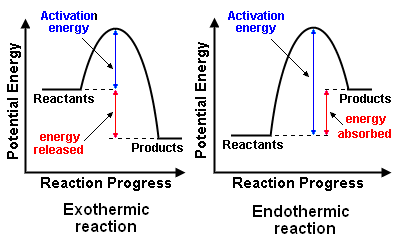Chemical reaction

A typical reaction path. In this example, energy is released. See Bergmann et al.[1].
A chemical reaction is a process that transforms one set of chemical substances to another. The study of chemical reactions is part of the field of science called chemistry.[2]
Chemical reactions can result in molecules attaching to each other to form larger molecules, molecules breaking apart to form two or more smaller molecules, or rearrangement of atoms within or across molecules. Chemical reactions usually involve the making or breaking of chemical bonds, and in some types of reaction may involve production of electrically charged end products. Reactions can occur in various environments: gases, liquids, solids, or combinations of same: for example, at interfaces.
As shown in the adjacent figure for a general case, the participating reactants typically must surmount a threshold energy or activation energy to initiate the reaction, and intermediates exist briefly before the final products are formed. Changes in bonding of a single occurrence of the transformation is not all that is involved in the energy depicted, which is intended to show the evolution of an entire soup of reactants, intermediates and products. This evolution typically involves generation of heat, physical motion and mixing of all the participants, and the chemical reactions. In the figure, the activation energy on the left indicates the change in all these factors needed to surmount the activation threshold and the energy output on the right indicates the change in these factors when the reaction is complete, being the difference between the starting system with only the reactants themselves and the ending system consisting only of the final products. This overall change in energy may be made to do useful work, or simply be dissipated as heat.[3]
Chemical reactions can be either spontaneous[4] and require no input of energy, or non-spontaneous[4] which often require the input of some type of energy such as heat, light or electricity. Classically, chemical reactions are strictly transformations that involve the movement of electrons during the forming and breaking of chemical bonds. A more general concept of a chemical reaction would include nuclear reactions and elementary particle reactions.
Energy changes in reactions
In terms of the energy changes that take place during chemical reactions, a reaction may be either exothermic or endothermic ... terms which were first coined by the French chemist Marcellin Berthelot (1827 − 1907). The meaning of those terms and the difference between them are discussed below and illustrated in the adjacent diagram of the energy profiles for exothermic and endothermic reactions.
Exothermic reactions
Exothermic chemical reactions release energy. The released energy may be in the form of heat, light (for example, flame), electricity (for example, battery discharge), sound and shock waves (for example, explosion) … either singly or in combinations.
A few examples of exothermic reactions are:
- Mixing of acids and alkalis (releases heat)
- Combustion of fuels (releases heat and light)
Endothermic reactions
Endothermic chemical reactions absorb energy. The energy absorbed may be in various forms just as is the case with exothermic reactions:
A few examples of endothermic reactions are:
- Dissolving ammonium nitrate (NH4NO3) in water (H2O) (absorbs heat and cools the surroundings)
- Electrolysis of water to form hydrogen (H2) and oxygen (O2) gases (absorbs electricity)
- Photosynthesis of chlorophyll plus water plus sunlight to form carbohydrates and oxygen (absorbs light)
Reaction types
The common kinds of classical chemical reactions include:[8][9][10]
- Isomerization, in which a chemical compound undergoes a structural rearrangement without any change in its net atomic composition (see stereoisomerism)
- Direct combination or synthesis, in which 2 or more chemical elements or compounds unite to form a more complex product:
- Chemical decomposition in which a compound is decomposed into elements or smaller compounds:
- Single displacement or substitution, characterized by an element being displaced out of a compound by a more reactive element:
- Metathesis or double displacement, in which two compounds exchange ions or bonds to form different compounds:
- Acid-base reactions, broadly characterized as reactions between an acid and a base, can have different definitions depending on the acid-base concept employed. Some of the most common are:
- Arrhenius definition: Acids dissociate in water releasing H3O+ ions; bases dissociate in water releasing OH− ions.
- Brønsted-Lowry definition: Acids are proton (H+) donors; bases are proton acceptors. Includes the Arrhenius definition.
- Lewis definition: Acids are electron-pair acceptors; bases are electron-pair donors. Includes the Brønsted-Lowry definition.
- Redox reactions, in which changes in the oxidation numbers of atoms in the involved species occur. Those reactions can often be interpreted as transferences of electrons between different molecular sites or species. An example of a redox reaction is:
- 2 S2O32−(aq) + I2(aq) → S4O62−(aq) + 2 I−(aq)
- In which iodine (I2) is reduced to the iodine anion (I−) and the thiosulfate anion (S2O32−) is oxidized to the tetrathionate anion (S4O62−).
- Combustion, a kind of redox reaction in which any combustible substance combines with an oxidizing element, usually oxygen, to generate heat and form oxidized products.
- Disproportionation with one reactant forming two distinct products varying in oxidation state.
- 2 Sn2+ → Sn + Sn4+
- Organic reactions encompass a wide assortment of reactions involving organic compounds which are chemical compounds having carbon as the main element in their molecular structure. The reactions in which an organic compound may take part are largely defined by its functional groups.
References
- ↑ Nikolaus Risch (2002). “Molecules - bonds and reactions”, L. Bergmann et al.: Constituents of Matter: Atoms, Molecules, Nuclei, and Particles. CRC Press. ISBN 0-8493-1202-7.
- ↑ Chemistry Explained Chemistry Encyclopedia
- ↑ For a qualitative discussion see, for example, John W. Moore, Conrad L. Stanitski, Peter C. Jurs (2009). “Coupling reactant-favored processes with product-favored processes”, Principles of Chemistry: The Molecular Science. Cengage Learning, pp. 633 ff. ISBN 0495390798. and Eric V. Anslyn, Dennis A. Dougherty (2006). “§2.1.2: Types of energy”, Modern physical organic chemistry. University Science Books, pp. 68 ff. ISBN 1891389319.
- ↑ Jump up to: 4.0 4.1 Mark Rosengarten (2009). Chemistry tutorial 9.03: Entropy, enthalpy and spontaneous reactions. Regents chemistry tutorials on YouTube. Retrieved on 2011-04-06.
- ↑ Examples of Organic Reactions Virtual Textbook of Organic Chemistry, William Reusch, Emeritus Professor, Department of Chemistry, Michigan State University. Scroll down to section on "Activation Energy".
- ↑ Frederick A. Bettelheim, William H. Brown, Mary K. Campbell and Shawn O. Farrell (2009). Introduction to General, Organic and Biochemistry. Brooks/Cole, Cengage Learning, pp.215-216. ISBN 0-495-39112-3. Partally available here at Google Books.
- ↑ Paul Collison, David Kirkby and Averil Macdonald (2003). “§10.08: Energy changes in chemical reactions”, Nelson Modular Science, Book 2. Nelson Thornes Ltd., pp. 151 ff. ISBN 0748767797.
- ↑ In the following chemical equations, (aq) indicates an aqueous solution, (g) indicates a gas and (s) indicates a solid. Superscripts with a positive sign (+) indicate an cation and superscripts with a negative sign (−) indicate an anion.
- ↑ H. Stephen Stoker (2009). “Chapter 9: Chemical reactions”, General, Organic, and Biological Chemistry, 5th Edition. Brooks/Cole: Cengage Learning, pp. 223 ff. ISBN 0547152817.
- ↑ Mark S. Cracolice and Edward I. Peters (2009). “§2.8: Characteristics of a chemical change”, Introductory Chemistry: An Active Learning Approach, 4th Edition. Brooks/Cole: Cengage Learning, pp. 77 ff. ISBN 0-495-55847-8.
